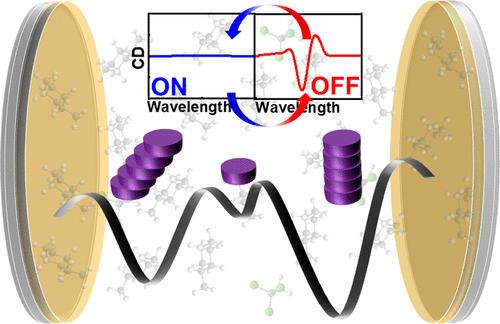当前位置:
X-MOL 学术
›
J. Am. Chem. Soc.
›
论文详情
Our official English website, www.x-mol.net, welcomes your feedback! (Note: you will need to create a separate account there.)
Consequences of Vibrational Strong Coupling on Supramolecular Polymerization of Porphyrins
Journal of the American Chemical Society ( IF 15.0 ) Pub Date : 2024-04-20 , DOI: 10.1021/jacs.4c02267 Kripa Joseph 1 , Bas de Waal 1 , Stef A. H. Jansen 1 , Joost J. B. van der Tol 1 , Ghislaine Vantomme 1 , E. W. Meijer 1
Journal of the American Chemical Society ( IF 15.0 ) Pub Date : 2024-04-20 , DOI: 10.1021/jacs.4c02267 Kripa Joseph 1 , Bas de Waal 1 , Stef A. H. Jansen 1 , Joost J. B. van der Tol 1 , Ghislaine Vantomme 1 , E. W. Meijer 1
Affiliation

|
Supramolecular polymers display interesting optoelectronic properties and, thus, deploy multiple applications based on their molecular arrangement. However, controlling supramolecular interactions to achieve a desirable molecular organization is not straightforward. Over the past decade, light–matter strong coupling has emerged as a new tool for modifying chemical and material properties. This novel approach has also been shown to alter the morphology of supramolecular organization by coupling the vibrational bands of solute and solvent to the optical modes of a Fabry–Perot cavity (vibrational strong coupling, VSC). Here, we study the effect of VSC on the supramolecular polymerization of chiral zinc-porphyrins (S-Zn) via a cooperative effect. Electronic circular dichroism (ECD) measurements indicate that the elongation temperature (Te) of the supramolecular polymerization is lowered by ∼10 °C under VSC. We have also generalized this effect by exploring other supramolecular systems under strong coupling conditions. The results indicate that the solute–solvent interactions are modified under VSC, which destabilizes the nuclei of the supramolecular polymer at higher temperatures. These findings demonstrate that the VSC can indeed be used as a tool to control the energy landscape of supramolecular polymerization. Furthermore, we use this unique approach to switch between the states formed under ON- and OFF-resonance conditions, achieved by simply tuning the optical cavity in and out of resonance.
中文翻译:

振动强耦合对卟啉超分子聚合的影响
超分子聚合物表现出有趣的光电特性,因此可以根据其分子排列部署多种应用。然而,控制超分子相互作用以实现理想的分子组织并不简单。在过去的十年中,光-物质强耦合已成为改变化学和材料特性的新工具。这种新颖的方法还被证明可以通过将溶质和溶剂的振动带耦合到法布里-珀罗腔的光学模式(振动强耦合,VSC)来改变超分子组织的形态。在这里,我们通过协同效应研究了 VSC 对手性锌卟啉 ( S- Zn )超分子聚合的影响。电子圆二色性 (ECD) 测量表明,VSC 下超分子聚合的延伸温度 ( T e ) 降低了约 10 °C。我们还通过探索强耦合条件下的其他超分子系统推广了这种效应。结果表明,VSC 下溶质-溶剂相互作用发生了改变,这使得超分子聚合物的核在较高温度下变得不稳定。这些发现表明,VSC 确实可以用作控制超分子聚合能量景观的工具。此外,我们使用这种独特的方法在开谐振和关谐振条件下形成的状态之间进行切换,这是通过简单地将光学腔调入和调出谐振来实现的。
更新日期:2024-04-20
中文翻译:

振动强耦合对卟啉超分子聚合的影响
超分子聚合物表现出有趣的光电特性,因此可以根据其分子排列部署多种应用。然而,控制超分子相互作用以实现理想的分子组织并不简单。在过去的十年中,光-物质强耦合已成为改变化学和材料特性的新工具。这种新颖的方法还被证明可以通过将溶质和溶剂的振动带耦合到法布里-珀罗腔的光学模式(振动强耦合,VSC)来改变超分子组织的形态。在这里,我们通过协同效应研究了 VSC 对手性锌卟啉 ( S- Zn )超分子聚合的影响。电子圆二色性 (ECD) 测量表明,VSC 下超分子聚合的延伸温度 ( T e ) 降低了约 10 °C。我们还通过探索强耦合条件下的其他超分子系统推广了这种效应。结果表明,VSC 下溶质-溶剂相互作用发生了改变,这使得超分子聚合物的核在较高温度下变得不稳定。这些发现表明,VSC 确实可以用作控制超分子聚合能量景观的工具。此外,我们使用这种独特的方法在开谐振和关谐振条件下形成的状态之间进行切换,这是通过简单地将光学腔调入和调出谐振来实现的。



























 京公网安备 11010802027423号
京公网安备 11010802027423号